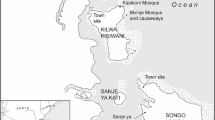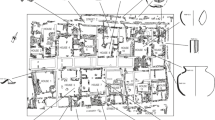Abstract
Glass ornaments such as bangles are widely distributed along trade routes between the East and West, indicating interactions and exchange between manufacturing and consumption sites. In the Persian Gulf region, numerous glass bangles have been excavated from late 2nd millennium CE contexts, but few of these have been studied with scientific analysis. Here, we report data on 56 representative samples from assemblages found at seven coastal sites of northern Qatar that date between the eighteenth and twentieth centuries CE, analysed by laser ablation–inductively coupled plasma–mass spectrometry (LA-ICP-MS). We identify six different glass compositions and discuss their raw materials and likely provenances, including one group from the Levant, one group from Mesopotamia and another two groups using different plant types as fluxes, with their sand source similar to Sasanian glasses from Central Iraq between the third and seventh centuries CE, and two high-alumina outliers associated with two Indian origins. The paper also compares the Qatar bangles with others from the Islamic world and India to discuss differences and similarities between them.









Similar content being viewed by others
References
Adlington LW (2017) The Corning Archaeological Reference Glasses: new values for “old” compositions. Papers from Institute of Archaeology 27(1):1–8. https://doi.org/10.5334/pia-515
Al-Bashaireh K (2016) Production technology of glass bracelets from the west cemetery of Umm el-Jimal in northeastern Jordan. Mediter Archaeol Archaeom 16(3):17–34
Al-Bashaireh K, Freestone IC, Gregory T (2022) Composition of glass bracelets and rings from the Ayyubid-Mamluk cemetery at Dohaleh, north Jordan. J Archaeol Sci Rep 46:103689
Barkoudah Y, Henderson J (2006) Plant ashes from Syria and the manufacture of ancient glass: Ethnographic and scientific aspects. J Glass Stud 48:297–321
Boulogne S, Hardy-Guilbert C (2010) Glass bangles of al-Shiḥr, Ḥaḍramawt (fourteenth-nineteenth centuries), a corpus of new data for the understanding of glass bangle manufacture in Yemen. Proceedings of the Seminar for Arabian Studies 40:135–148
Boulogne S, Henderson J (2009) Indian glass in the Middle East? Medieval and Ottoman glass bangles from Central Jordan. J Glass Stud 51:53–75
Brill RH (1999) Chemical analysis of early glasses, vols. I and II, Corning Museum of Glass, New York
Carter RA (2020) Pearl fishing, migration and globalization in the Persian Gulf, 18th-20th centuries AD. In: Machado P et al (eds) Pearls, people and power. Ohio University Press, pp 232–262
Carter RA, Eddisford D (2016) Archaeological investigation at Fuwairit: end of the season summary report 2016. UCL Qatar
Carter RA, Eddisford D (2018) Origins of Doha Project- season 6 interim report: archaeological excavation at Fuwairit. Report 2018. UCL Qatar
Carter RA, Zhao B, Lane K, Velde C (2020) The rise and ruin of a medieval port town: a reconsideration of the development of Julfar. Arab Archaeol Epigr 31(ii):501–523
Corning Museum of Glass (2013) The glassmaker of Herat. https://blog.cmog.org/2013/04/17/the-glassmakers-of-herat/. Accessed 5 Oct 2023
Degryse P, Shortland A (2009) Trace elements in provenancing raw materials for Roman glass production. Geol Belg 12(3–4):135–143
Duckworth CN, Mattingly DJ, Chenery S, Smith VC (2016) End of the line? Glass bangles, technology, recycling, and trade in Islamic North Africa. J Glass Stud 58:135–169
Dussubieux L, Kusimba CM, Gogte V, Kusimba SB, Gratuze B et al (2008) The trading of ancient glass beads: new analytical data from South Asian and East African soda-alumina glass beads. Archaeometry 50:797–821
Dussubieux L, Robertshaw P, Glascock MD (2009) LA-ICP-MS analysis of African glass beads: laboratory inter-comparison with an emphasis on the impact of corrosion on data interpretation. Int J Mass Spectrom 284(1–3):152–161
Dussubieux L, Gratuze B (2003) Origine et diffusion du verre dans le monde Indien et en Asie du sud-est: L’Importance du dosage des éléments-traces. Rev Archeometrie 27:67–73
Fiorentino S, Venezia B, Schibille N, Vandini M (2019) Streams across the Silk Roads? The case of Islamic glass from Ghazni. J Archaeol Sci Rep 25:153–170
Freestone IC (2002) Composition and affinities of glass from the furnaces on the island Site, Tyre. J Glass Stud 44:67–77
Freestone IC (2006) Glass production in Late Antiquity and the Early Islamic period: a geochemical perspective. In: Maggetti M, Messiga B (eds) Geomaterials in Cultural Heritage. Geological Soc Publishing House, Bath, pp 201–216
Freestone IC, Jackson-Tal RE, Tal O (2008) Raw glass and the production of glass vessels at Late Byzantine Apollonia-Arsuf, Israel. J Glass Stud 50:67–80
Gratuze B (2016) Glass characterization using laser ablation-inductively coupled plasma-mass spectrometry methods. In: Dussubieux L, Golitko M, Gratuze B (eds) Recent advances in laser ablation ICP-MS for archaeology, Series: Natural Science in Archaeology. Springer, Berlin, pp 179–196
Gratuze B (2014) Application de la spectrome´trie de masse à plasma avec pre´lèvement par ablation laser (LA-ICP-MS) à l’e´tude des recettes de fabrication et de la circulation des verres anciens. In: Dillmann P, Bellot-Gurlet L (eds). Circulation des matériaux et des objets dans les sociétés anciennes, Collection Sciences Archéologiques. Editions Archives Contemporaines, Paris, pp 259–291
Guido CM, Henderson J, Cable C, Bayley J, Biek L (1984) A Bronze Age glass bead from Wilsford, Wiltshire: Barrow G42 in the Lake Group. Proc Prehist Soc 50:245–254
Hao LB, Qi CM (2004) Rare-earth elements, chapter 2. In: The theory of geochemistry. Geology Publishing House, Beijing, pp 45–60. (In Chinese)
Haour A (2021) Chapter 8: The small finds. Archaeological investigations of the Maldives in the Medieval Islamic Period, Ibn Battuta’s Island. In: Haour A, Christie A (eds). Routledge, Taylor & Francis Group, pp 123–142
Heck M, Rehren Th (2003) The production of lead-tin yellow at Merovingian Schleitheim. Archaeometry 45:33–44
Henderson J, McLoughlin SD, McPhail DS (2004) Radical changes in Islamic glass technology: evidence for conservatism and experimentation with new glass recipes from early and middle Islamic Raqqa, Syria. Archaeometry 46:439–468
Henderson J (2000) Glass. The science and archaeology of materials – an investigation of inorganic materials. Routledge Taylor& Francis Group, London, pp 24–108
Jochum KP, Weis U, Stoll B, Kuzmin D, Yang Q, Raczek I, Jacob DE, Stracke A, Birbaum K, Frick DA, Günther D, Enzweiler J (2011) Determination of Reference Values for NIST SRM 610–617 glasses following ISO guidelines. Geostand Geoanal Res 35(4):397–429
Kanungo AK (2022) Glass bangles in India: antiquity, functional use and traditional production. South Asian Stud 38:19–39
Lane A, Sarjeant RB (1948) Pottery and glass fragments from the Aden Littoral, with historic notes. J R Asiat Soc 2:108–133
Lankton JW, Dussubieux L (2006) Early glass in Asian maritime trade: a review and an interpretation of compositional analyses. J Glass Stud 48:121–144
Meyer C (1992) Glass from Quseir al-Qadium and the Indian Ocean trade, studies in ancient oriental civilization, vol. 53. Oriental Institute of the University of Chicago, Chicago, pp 90–91
Mirti P, Pace MN, Ponzi MM, Aceto M (2008) ICP-MS analysis of glass fragments of Parthian and Sasanian epoch from Seleucia and Veh Ardašîr (Central Iraq). Archaeometry 50:429–450
Mirti P, Pace M, Malandrino M, Negro Ponzi M (2009) Sasanian glass from Veh Ardašîr: new evidences by ICP-MS analysis. J Archaeol Sci 36:1061–1069
Ogutu J (2018a) Sample selection from other sites in Qatar (Al Huwaila, Al Zubarah, Al Yousefiya, Freiha, Al Rubaiqa and Al Ruwaida). Unpublished report
Ogutu J (2018b) Poster: Typological and chronological description of glass bangles from Fuwairt northern Qatar (18th to 19th century AD). In the Seminar for Arabian Studies held at the British Museum
Phelps M, Simpson StJ, Freestone IC (2018) The early Islamic glass from Sir Bani Yas, UAE. Proceedings of the Seminar for Arabian Studies 48:249–267
Rehren Th, Freestone IC (2015) Ancient glass: from kaleidoscope to crystal ball. J Archaeol Sci 56:233–241
Rehren Th, Pusch E (2006) Late Bronze Age Egyptian glass production at Qantir-Piramesses. Science 308(5729):1756–1758
Rehren Th, Osorio A, Anarbaev A (2010) Some notes on early Islamic glass in eastern Uzbekistan. In: Zorn B, Hilgner A (eds.) Glass along the Silk Road from 200 BC to AD 1000. RGZM, Mainz, pp 93–103
Robertshaw P, Rasoarifetra B, Wood M, Melchiorre E, Popelka-Filcoff RS, Glascock MD (2006) Chemical analysis of glass beads from Madagascar. J Afr Archaeol 4:91–109
Sasaki T (1993) Excavations at Julfar in the 1992 season. Bull Archaeol Univ Kanazawa 20:1–49
Sasaki T (1994) 1993 excavations at Julfar. Bull Archaeol Univ Kanazawa 21:1–106
Sayre EV, Smith RW (1961) Compositional categories of ancient glass. Science 133:1824–1826
Schibille N (2011) Late Byzantine mineral soda high alumina glasses from Asia Minor: a new primary glass production group. PLoS ONE 6(4):e18970
Schibille N, Meek A, Tobias B, Entwistle C, Avisseau-Broustet M, Da Mota H (2016) Comprehensive chemical characterisation of Byzantine glass weights. PLoS ONE 11(12):e0168289
Schibille N, Meek A, Wypyski MT, Kröger J, Rosser-Owen M, Wade Haddon R (2018) The glass walls of Samarra (Iraq): ninth-century Abbasid glass production and imports. PLoS ONE 13(8):e0201749
Spaer M (1992) The Islamic glass bracelets of Palestine: preliminary findings. J Glass Stud 34:44–62
Swan CM, Rehren Th, Lankton J, Gratuze B, Brill RH (2017) Compositional observations for Islamic glass from Sīrāf, Iran, in the Corning Museum of Glass collection. J Archaeol Sci Rep 16:102–116
Van Gosen BS, Verplanck PL, Seal II RR, Long KR, Gambogi J (2017) Rare-earth elements. In: Schulz KJ, DeYoung Jr JH, Seal II RR, Bradley DC (eds). Critical mineral resources of the United States—economic and environmental geology and prospects for future supply. U.S. Geological Survey Professional Paper 1802, pp O1–O31. https://doi.org/10.3133/pp1802O
Van Ham-Meert A, Claeys P, Jasim S, Overlaet B, Yousif E, Degryse P (2019) Plant ash glass from first century CE Dibba, U.A.E. Archaeol Anthropol Sci 11(4):1431–1441
von Saldern A (1980) Ancient and Byzantine glass from Sardis. Mass, Cambridge. Harvard University Press
Wagner B, Nowak A, Bulska E, Hametner K, Günther D (2012) Critical assessment of the elemental composition of Corning archeological reference glasses by LA-ICP-MS. Anal Bioanal Chem 402(4):1667–1677
Welter N, Schüssler U (2007) Characterisation of inorganic pigments in ancient glass beads by means of Raman microspectroscopy, microprobe analysis and X-ray diffractometry. J Raman Spectrosc 38:113–121
Zhang R (2017) Preliminary report on the Far Eastern ceramics from the Doha excavations, unpublished
Acknowledgements
Thanks are given to Bernard Gratuze at IRAMAR-CEB in Orléans, France who conducted the LA-ICP-MS analyses. Thanks are also given to the Chinese Scholarship Council which funded the first author working for nearly a year in STARC at the Cyprus Institute between 2021-2022 (Project ID: 202009110007). Further thanks are due to Mr Faisal Abdullah Al-Naimi of Qatar Museums for facilitating the study, and to Dr Ferhan Sakal and Dr Alice Bianchi. Finally, thanks are given to the China Natural Science Committee who funds the research project: Application of Synchrotron Analysis on Glasses from Land and Maritime Silk Road (U2032130).
Funding
This work has been generated by project Application of Synchrotron Analysis on Glasses from Land and Maritime Silk Road (ID: U2032130), funded by National Nature Science of China and project funded by Chinese Scholarship Council (ID: 202009110007).
Author information
Authors and Affiliations
Contributions
Q.C. wrote the main manuscript text and all co-authors made contributions. J.O. wrote material section. Th.R. reviewed the manuscript and three appendixes. R.A.C. organised the initial bangle study, sample collection and laboratory analyses, prepared Figs. 1 and 2, added observations about regional and international trade and checked the manuscript.
Corresponding authors
Ethics declarations
Competing interests
The authors declare no competing interests.
Additional information
Publisher's Note
Springer Nature remains neutral with regard to jurisdictional claims in published maps and institutional affiliations.
Supplementary Information
Below is the link to the electronic supplementary material.
Rights and permissions
Springer Nature or its licensor (e.g. a society or other partner) holds exclusive rights to this article under a publishing agreement with the author(s) or other rightsholder(s); author self-archiving of the accepted manuscript version of this article is solely governed by the terms of such publishing agreement and applicable law.
About this article
Cite this article
Cheng, Q., Rehren, T., Ogutu, J. et al. Glass ornaments in the Late Islamic period: composition of glass bangles from northern Qatar. Archaeol Anthropol Sci 16, 11 (2024). https://doi.org/10.1007/s12520-023-01903-4
Received:
Accepted:
Published:
DOI: https://doi.org/10.1007/s12520-023-01903-4




